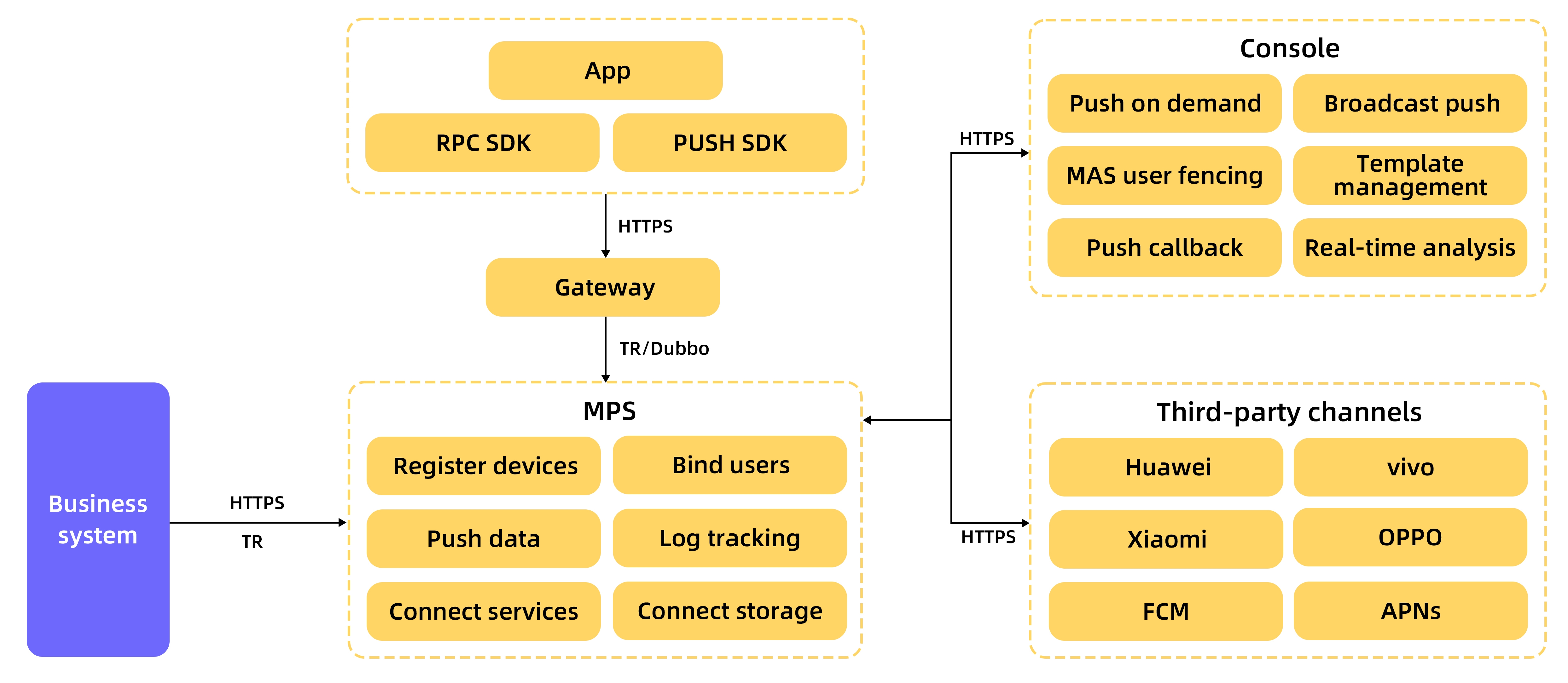Message Push Service (MPS) provided by mPaaS is a professional mobile message push solution and supports various push types for different scenarios to cater to personalized push requirements. To improve the arrival rate of pushed messages, mPaaS integrates the push functions of Huawei, Xiaomi and other vendors in MPS. In addition to the capability of quickly pushing messages in the console, mPaaS provides server-side integration solutions. With these solutions, you can quickly integrate the function of pushing messages to mobile devices to keep interactions with app users, thereby effectively improving the user retention rate and user experience.
Features
You can initiate various types of message push through MPS. Both self-built and vendors' push channels are supported. In addition, messages can be pushed through the console or APIs. You can select push types, channels, and modes based on your requirements.
The core functions of MPS are described as follows:
Multiple push modes: Messages can be precisely pushed to custom user groups, individual users, or all users through the MPS console or APIs.
Custom message validity period: If a device is offline when a message is sent for the first time, the message can be resent when the device is connected or a user binding request is initiated within the validity period of the message.
Different types of push targets: You can establish mapping between devices and login users to push messages by device or user ID.
Personalized message templates: On the template management page, you can customize templates to meet your personalized push requirements.
Usage analysis: Based on tracking logs reported by the client SDK, MPS collects and analyzes push data from various dimensions including platform, version, push channel, push type, and time, and generates analysis reports. You can view the statistics by minute or other granularity.
Push configuration: On the push configuration page, you can configure a push certificate. For iOS devices, you can select an Apple APNs gateway based on your requirements.
Channel configuration: You can configure third-party push channels to integrate the push functions provided by Huawei, Xiaomi, and other third-party vendors, thereby improving the arrival rate of pushed messages.
Key management: All external APIs of MPS will sign the requests to ensure business security. On the key configuration page, you can configure keys based on your requirements. In addition, the message receipt function is provided for tracking the message delivery results.
Principle
In mPaaS, MPS is one of the core basic components that directly interact with clients. It transmits business data related to message notifications through TCP persistent connection channels or various phone vendors' push channels.
The client calls the Remote Procedure Call (RPC) gateway through mPaaS MGS for device registration, user binding, and third-party channel binding, thereby implementing message push by device and user. Client behavioral event tracking logs are collected and uploaded based on specifications. Based on the logs, the backend collects and analyzes push data in real time and generate statistical reports. MPS provides two push methods. You can either call APIs on your server based on the business logic to push personalized messages or directly push messages in the console. To improve the arrival rate of messages, MPS supports third-party push channels such as those provided by Huawei, Xiaomi, FCM, and APNs and keeps transparent to backend business systems. In this way, the business systems can focus on business function implementation, and don’t need to pay attention to device models.

Advantages
MPS has the following advantages:
Quick and stable: Messages are delivered quickly and arrive at targets stably.
Easy to access: You can complete MPS access efficiently at a low cost.
Quantified push effect: The push data statistics function is integrated to intelligently analyze the arrival rate and open rate of messages. This helps you clearly understand the push effects.
Precise personalized push:
Personalized messages can be precisely pushed from various dimensions such as individual users and custom user groups.
A push console is provided to meet some simple push requirements. In addition, server-side integration solutions are provided to implement complex push requirements.
Message receipts are supported to track the message delivery results, improving the user retention rate and user activeness effectively.
Mapping between device IDs and app user IDs is established. The app user name can be directly used as the message recipient. In this way, messages can accurately arrive at any devices to which the user logs in.
Application scenarios
Typical application scenarios for MPS are as follows:
Marketing activities
Push targeted messages to users, including marketing activities, business reminders, etc., to increase user stickiness. By calling the message push API, the app pushes targeted messages to target users to reach more users in a more active way, which attracts user, increases consumption, and improves the conversion effect of final marketing activities.
System notification
According to the business logic of the app server, specify the target user group, and directly push the message to the target device.
The following push modes are supported to accommodate different application scenarios:
Simple Push: Quickly push messages to a single user or device with simple configuration.
Template Push: Push messages to a single user or device, a message template can be specified, and the message body is obtained by replacing the template placeholder.
Multiple Push: Push messages to a number of devices or users , you can specify a message template and set different placeholder variable values for different devices or users in the configuration file.
Broadcast Push: Push to devices on the entire network, you can specify a message template, the message body is obtained by replacing the template placeholder.